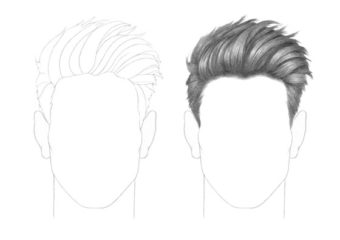How to Draw Different Eye Types Step by Step
This tutorial shows how to draw three common variations of eyes with step by step pencil drawing examples and instructions for each type.

The three variations of eyes in this tutorial include:
- Inner Angled Eyes
- Non-Angled Eyes
- Outwards Angled Eyes
The instructions and examples consist of two parts, the line drawing and the shading.
In this case the line drawing will be used as more of a “construction frame” for the shading instead of a stand alone drawing. For this reason please be sure to make very light lines that will blend into the shading once you are finished. The lines in some of the examples have been made darker simply so that they are easier for you to see.
Very importantly please note that as the shading process for each set of eyes is very similar so the first example provides the most detailed instructions. It’s recommended that you read over these regardless of which pair of eyes you want to draw. The rest of the examples have less instructions to avoid repetition.
Drawing Inner Angled Eyes
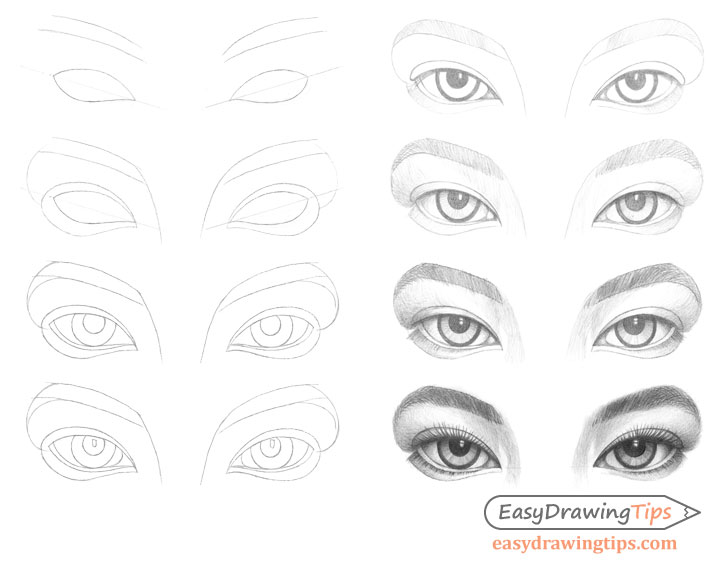
This example of the eyes is angled downwards towards the nose. However please don’t confuse the angled guide lines in the next step with the angle of the eyes. The “eye angles” in this tutorial refer to the balance of the overall shape of each eye.
Step 1 – Draw the Outlines of the Eyes & Eyebrows

Begin by making a pair of lines that will act as guides to help you make sure that the top and bottom halves of each eye are similar in proportion to the other. Draw the outlines of the eyes based on these lines (as shown in above example). Also be sure to space the eyes far enough apart that you can fit at least one other eye between them.
As short distance above the outlines of the eyes add the basic shapes of the eyebrows. At this stage you can do it with just a pair of lines for each eyebrow.
For this pair of eyes the eyebrows will be angled a fair bit towards the nose similar to the eyes.
Step 2 – Add the Eyelids
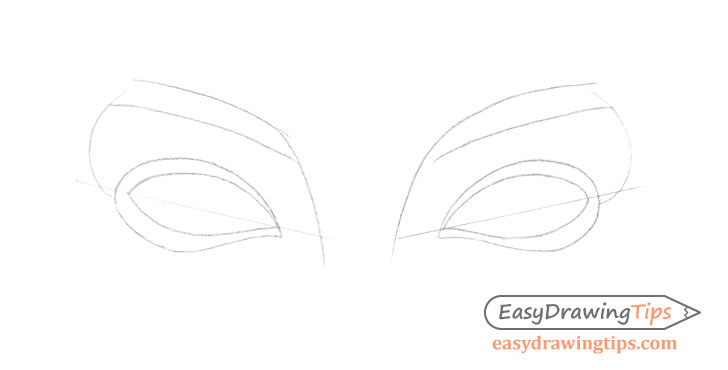
Around the shapes of the eyes draw the outlines of the eyelids. After that add the bridge of the nose that will merge into the eyebrows as shown in the example.
Finally you can also add a pair of curves between the outer parts of the eyebrows and the out tips of the eyes. These will help define the shape of the “around the eyes” area of the face.
Step 3 – Draw the Irises & Pupils

Erase the guide lines from the first step and inside each eye draw the iris and pupil. As the eyes in this case are in a fairly relaxed/natural state the top portions of these should be covered by the eyelids. If you make the entire iris visible the eyes can end up with a “crazy stare” kind of look.
You can also add another line to the bottom of each eyelid to show their edges/thickness.
Step 4 – Draw the Highlights & Other Details

At the inner end of each eye draw the tear duct areas. Afterwards add a small outline of the highlights inside each pupil (light being reflected by the eye). The shape of these highlights will generally be determined by the shape of the light source. You will want to leave these areas white when shading.
Step 5 – Begin Shading

Before you begin shading anything (eyes included) it’s a good idea to be aware of the setup of the lighting. In this particular case it will be fairly generic as though the subject is outside during the day or in a well lit room with the light coming from above. This means that most shadow will be cast downwards and the areas that and “indented” will tend to be darker.
When you being the actual shading process make the initial layer of strokes fairly light. The goal of this step is to create something like a “shading map” for yourself. If you press on the pencil too hard you may make some areas too dark in relation to others to the point where it no longer has enough dark value to create the correct difference between them. This is why you want to apply the shading gradually in several layers. While eventually the initial strokes will be covered by more layers of shading it’s still good practice to maintain their proper distance and direction.
For the eyebrows try and apply the strokes in the direction of the growth of the eyelashes and keep a good amount of space between them to create the effect of hair. When shading the inner parts of the eyes (irises/pupils) you will want to do the opposite and completely blend the strokes to show that those areas are smooth and reflective.
For more good drawing practices also see:
Beginner Guide to Learning to Draw
Step 6 – Continue Shading

Apply the next layer of shading strokes on a slight angle to the first layer so that they create a crosshatch. The only exception to that in this case can be the inner ends of the eyebrows. As the hair there tends to grow in pretty much one direction you can keep making all of the strokes in the same direction as well.
For an explanation of different stroke types see:
Shading Techniques and Stroke Types Drawing Tutorial
Step 7 – Refine the Shading
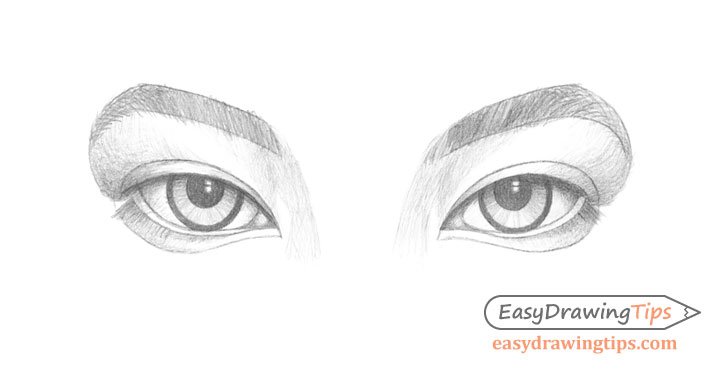
Darken the shading further by applying more layers of strokes bringing it close to the light/dark contrast you want to have in the finished drawing.
Step 8 – Finish the Eye Drawing

Fully darken the shading and smooth out the gradients (transitions from light to dark). To smooth out the gradients you can slightly blend the strokes in areas where they are too visible and add filler strokes wherever there might not be enough shading.
Once done with the shading add the eyelashes. To create these make quick curved strokes drawing outwards from the edge of the eyelids. Apply a good amount of pressure to the pencil and then quickly pull it away from the paper.
You can trace over the eyelashes with more sets of strokes if they don’t come out dark or thick enough the first time. You can use a similar method inside the eyebrows and make some very dark short strokes (especially towards the outer ends) that show individual hairs.
Drawing Non-Angled Eyes

These types of eyes don’t have much of an angle in either direction. Again similar to the first pair of eyes don’t confuse the angled guide lines in the next step with the overall angle of the eyes.
As already mentioned the “eye angle” in this tutorial refers to the overall balance of the shape of the eyes.
Step 1 – Draw the Outlines of the Eyes & Eyebrows

Star by drawing a pair of angled guide lines that you can then use to help you draw the outer shapes of the eyes.
Draw each eye with just two curves, one for the top and one for the bottom split by the lines. Be sure to leave enough space in between the eyes to at least fit in another eye.
After you finish the eyes draw just a few lines to get the shape and angle of the eyebrows. In this case they will again be angled towards the nose but less so than the previous example.
Step 2 – Add the Eyelids

Around the eyes draw the basic outlines of the eyelids. Next coming down from the eyebrows draw the bridge of the nose followed by a pair of curves coming down from the opposite ends of the eyebrows to define the shape of the “around the eyes” area.
Step 3 – Draw the Irises & Pupils

Erse the guide lines from step one and inside the outlines of the eyes draw the irises and pupils. Make sure that the top of each iris is covered by the top eyelid so that they eyes don’t end up with a “stare” look.
Below the bottom eyelid draw an additional line pretty much tracing it’s shape to show it’s edge/thickness.
Step 4 – Draw the Highlights & Other Details

In the inner corner of each eye draw the tear duct area and inside each pupil outline the highlight (light reflecting form the smooth surface of the eyes).
Step 5 – Begin Shading

As mentioned explained for the previous set of eyes this shading will be done for fairly generic lighting conditions (well let room or daytime outdoors).
Begin shading the eyes with fairly light strokes (much lighter in all areas then you want to have for the final drawing). You can fully blend the shading inside the iris/pupil areas but leave some distance between your strokes on the rest of the drawing. Especially so on the eyebrows as the strokes can help you create an effect of hairs. You should also apply the strokes in the direction of the hair growth.
Step 6 – Continue Shading

For the areas that have visible strokes apply another set at a slightly different angle to the first one. The only exception to this can be the inner ends of the eyebrows where you can make all of the strokes one directional.
Step 7 – Refine the Shading

Keep shading with more layers of strokes to bring it close to the overall dark/light contrast close to what you want to have in the final drawing.
Step 8 – Finish the Eye Drawing

Finally smooth out the shading by sort of “patching up” any areas that need with additional strokes.
Afterwards add the eyelashes by making some quick curved strokes. Draw these starting from the edges of the eyelids by pressing harder on the pencil towards their base and then pull your hand away form the paper as you get to the tips. You can combine several strokes together if the eyelashes look too thin.
You can also use the same technique to add some hairs on the outer edges of the eyebrows.
Drawing Outer Angled Eyes
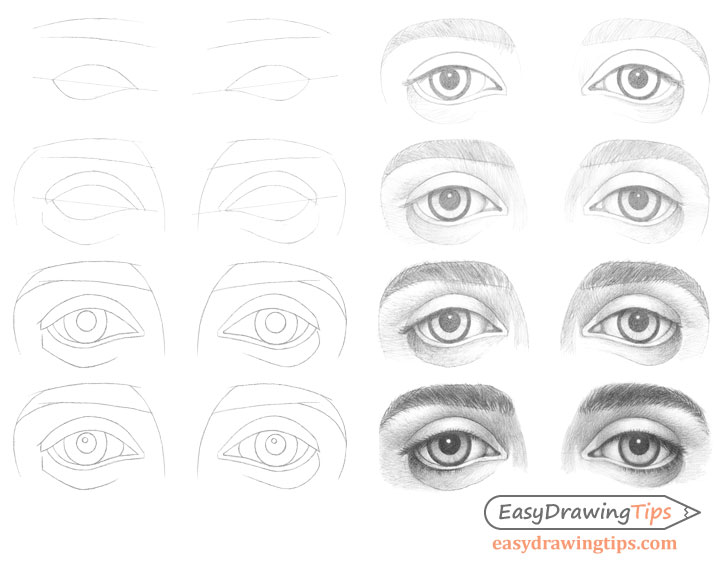
These eyes are angled downwards towards the ears.
Step 1 – Draw the Outlines of the Eyes & Eyebrows
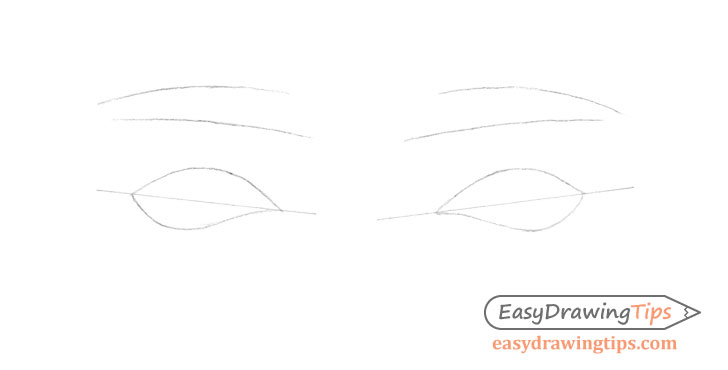
Begin by making a pair of guide lines as shown in the above example. Around these lines draw the outlines of the eyes. Keep these far enough apart so that you have the distance of at least the width of one eye between them.
Slightly above the eyes add a few lines to indicate the basic shape and angle of the eyebrows.
Step 2 – Add the Eyelids

Around the eyes draw the outlines of the eyebrows. Afterwards add the bridge of the nose as well as the outlines of the surrounding area. Both of these should merge into the eyebrows.
Step 3 – Draw the Irises & Pupils
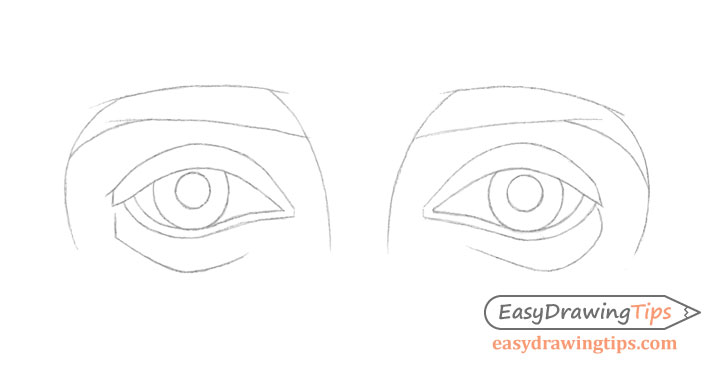
Erase the guide lines from step one and inside the outlines of the eyes draw the irises and pupils. Next below the bottom of each eye add another set of lines to establish the edges/thickness of the bottom eyelids.
Step 4 – Draw the Highlights & Other Details

Add the tear duct areas at the inner ends of the eyes followed by a pair of highlights inside the pupils to finish the line drawing.
Step 5 – Begin Shading

Same the the previous two various of the eyes this example will be shaded in fairly standard lighting conditions (well lit room or daytime outside).
Make the initial layer of shading fairly light. You can blend your strokes inside the irises/pupils but try and keep the rest of the strokes visible. Especially so when it comes to the eyebrows to help create the effect of hair.
Step 6 – Continue Shading

Add anther layer of shading over top of the first one gradually darkening the overall drawing. Try and make this set of strokes on a slightly different angle to the first one in the areas where the stroke are visible. The only exception to this can be the inner ends of the eyebrows where you can apply the strokes in pretty much the same direction as the fist set.
Step 7 – Refine the Shading

Apply even more layers of stroke to bring the dark and light balance of the drawing close to what you want to have once it’s finished.
Step 8 – Finish the Eye Drawing

Finish the shading by smoothing out the gradients and darkening the drawing where needed. Afterwards draw the eyebrows. Do this by making quick strokes where you first press fairly hard on the pencil and then quickly pull it away form the paper. This will help create eyelashes that are thicker towards their base and thinner towards their tips.
In this example the eyelashes of the top eyelid point more downwards than the previous example. This will make them appear shorter as they point more towards the viewer.
Conclusion
This tutorial shows how to draw some of the more common variations of the eyes. There are of course many more variations out there but the step by step line drawing and shading approach provided in this tutorial can be applied to drawing those as well.
For a tutorial on drawing different types of eyebrows see:
How to Draw Eyebrows Step by Step
For tutorials on drawing other parts of the face see:
- How to Draw Different Nose Types
- 3 Step Nose Side View Drawing Tutorial
- How to Draw an Ear From the Front Step by Step
- How to Draw Different Types of Lips
For tutorials on drawing the entire face see:
- How to Draw a Female Face Step by Step Tutorial
- Tips on Drawing the Same Male Face of Different Ages


